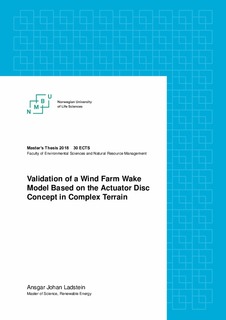| dc.description.abstract | A wind turbine operating downwind of another will stand in the wake of the upstream turbine, resulting in decreased power generation and increased load fatigue. In order to keep wake losses at a minimum, wind farm designers rely on wake models to optimize the wind farm layout. Therefore, accurate wind turbine wake aerodynamic modelling is essential for developing cost efficient modern wind farms, that consists of a large number of wind turbines usually congregated in compact formation.
Using large sets of SCADA data, which are, on-site measurements data from full scale wind turbines and meteorological data from a wind farm located in complex terrain in the northern part of Norway, the aim of this study was to perform a comparative analysis of the newly developed numerical wake model referred to as the actuator disc method (ACD), against the two most commonly known analytical wake models namely the Jensen- and Larsen model. The simulations were performed in the state of the art Computational Fluid Dynamics (CFD) software, WindSim, which solves the Reynolds Averaged Navier-Stokes (RANS) equations for wind farm development purposes.
Results of this study showed that the ACD and Larsen wake model outperformed the Jensen model for most single wake cases. For multiple wake cases, the ACD method was found to provide the most accurate results, by capturing wake-wake and wake-terrain effect. All three wake models overestimated the wake losses for the uncalibrated results in both single and multiple wake cases. However, Due to the poor quality in measurement data discovered during this study, no clear-cut conclusion can be drawn on to which wake model performed best. The main conclusion drawn in this study emphasises the necessity of high quality measurement data for wake model validation purposes. | nb_NO |

